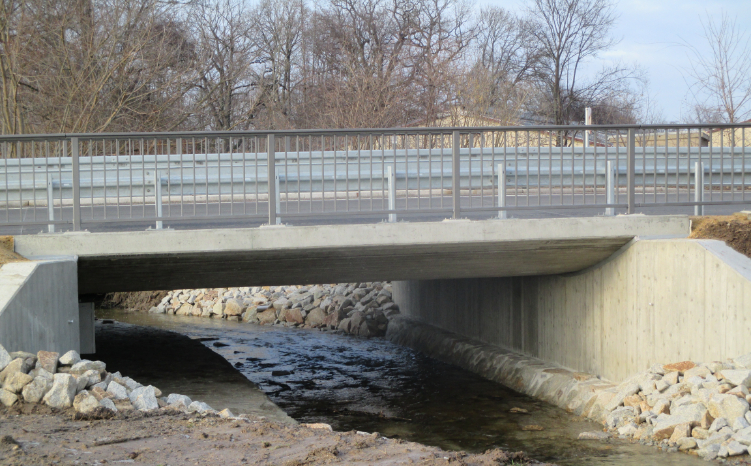Tags
With the replacement construction of the bridge over the Kuppritzer Water on the S 111 in Wurschen (Bautzen district, Eastern Saxony), a pioneering infrastructure project was realized in 2021: the first road bridge made of carbon concrete in the Free State of Saxony.
Project Description
Construction began on April 29, 2021, and was completed in December of the same year. The result is a single-span frame bridge with a solid slab cross-section and a span of approx. 6.60 m. While the substructures and foundations were built conventionally in steel-reinforced concrete, the superstructure consists entirely of carbon-reinforced concrete. Both carbon bars and carbon grids made of carbon fiber-reinforced polymer were used.
This innovative construction method significantly extends the service life of the bridge compared to conventional reinforced concrete structures, as the carbon reinforcement is corrosion-free and very durable.
Construction & Material Technology
- Reinforcement: Carbon grids & bars - solidian GRID and solidian REBAR made of high-strength carbon fiber
- Concrete: Standard structural concrete C30/37 – no special concrete required
- Production & Installation: Carbon reinforcement installed on-site in multiple layers and cast with in-situ concrete
- Combination: Superstructure in carbon concrete, substructure and foundations in steel reinforced concrete
- Special feature: fully corrosion-free in the superstructure – no concrete cover required for corrosion protection
Testing & Monitoring
The bridge was subjected to an extensive testing program:
- Load tests with crane vehicles weighing up to 60 t (static & dynamic)
- Monitoring using “Fiber-in-Metal-Tubes” for long-term condition assessment
- Material testing of the carbon reinforcement prior to installation
All tests confirmed load-bearing capacity and serviceability. In December 2021, the bridge was opened to all traffic – including heavy goods vehicles over 40 t.
Project Partners
The project was overseen by LISt GmbH (State Office for Road Construction and Transport, Saxony). Research partners were Technische Universität Dresden and RWTH Aachen, which developed the design principles for the use of carbon concrete in bridge construction. In addition, the C³ – Carbon Concrete Composite e.V. was involved.
Significance & Outlook
The replacement construction in Wurschen is a pilot project with strong signal value:
- Saxony’s first carbon concrete road bridge
- Trailblazer for the wider use of carbon concrete in infrastructure construction
- Contribution to extended service life and reduced maintenance costs in bridge construction
- Foundation for future standards and regulations
This project impressively demonstrates how the use of carbon concrete can create durable, sustainable, and resource-efficient infrastructure.
Photos:
© LISt GmbH on behalf of the client (Free State of Saxony, LASuV)
© Stephan Gröschel, TU Dresden







